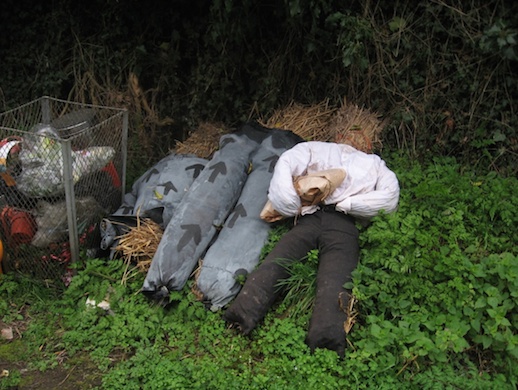The Intertidal Zone
by William Atkins
‘There was a melancholy wind, and the marshes were very dismal. A stranger would have found them unsupportable, and even to me they were so oppressive that I hesitated, half inclined to go back.’
– Charles Dickens, Great Expectations
Among the weeds in the corner of the churchyard, close to the marshes’ scrubby edge, two figures were laid down, one a child’s, the other cut in half at the waist.
For a while I’d been exploring the marshes of the Thames’s south bank, between two poles: St Mary’s church, in the village of Higham, Kent; and one of the last remaining acres of ancient Thames grazing marsh, twenty miles upstream, at Crossness. Whereas once marshland flanked the Thames from its mouth to what is now London, and beyond, its remaining strongholds resemble islands, islets – an acre here, an acre there – pressed round by housing and industry. I’d spent three years walking England’s moors, and had assumed that marsh was merely moorland’s lowland counterpart, another British desert: soggy, marginalised, uncultivable, despised. But marsh, it turned out, is a different beast: yes, less taxing for the walker, and easier to reach from London (Crossness is barely twenty minutes from London Bridge station) – but a more complex challenge to the spirit, somehow, possessed of a different order of threat. A dumping ground for all that the capital does not want. Indeed it is the very proximity of the city, heavy breathing on the horizon, combined with the daily inundation of the tides, that gives the Thames marshes their character, and their particular menace.
The city developed thirty miles upstream from the sea, at the first point where two banks of solid ground oppose each other across the river – here London Bridge could be built. It is this quirk of geography that accounts for the unusual distance between the river’s mouth and its docks. Joseph Conrad, who lived for a time in Stanford le Hope in Essex (then a marshland village), observed that the Thames was unique among British rivers in being ‘open to romantic feeling, from the fact that the sight of human labour and the sounds of human industry do not come down its shores to the very sea, destroying the suggestion of mysterious vastness’.
Tidal marsh is a terrain chiefly born of rivers: as silt is sluiced down from the land to the sea, the tides in turn lift it back onto the land. It is a tripartite place: first it is mudflats, covered daily by the tides. As silt accumulates on them, so the mudflats rise, until they stand clear of the sea for long enough to become colonised by salt-loving plants. Then they become saltmarsh. The saltmarshes are the Thames estuary’s richest habitat, home to purslane and aster, whose seeds are the major food source for the flocks of buntings and other finches you see here in winter.
A month or two from now the saltmarshes will turn first pink with thrift – ‘passing through all gradations of tint from maiden’s blush to lily white’, as Sabine Baring-Gould wrote – then deep purple as the sea lavender comes into flower. Rarely, golden samphire occurs, and silvery aromatic sea wormwood. When the saltmarsh is drained and walled off from the tide, it becomes grassland, dominated by meadow barley, strawberry clover and lady’s bedstraw.
Books have often been my maps, and it was a book that first sent me to St Mary’s church. It was there, a few springs back, that I came across those figures, cast down on the ground at the edge of the graveyard, amidst the greenest of nettles.
St Mary’s is one of the two or three Kent marshland churches said by competing factions to be Dickens’s model for the one visited by the marsh-boy, Pip, at the beginning of Great Expectations. Those who claim St Mary’s as the church observe that its architecture better matches the one in the book, and that it lies closer to Dickens’s home at Gad’s Hill. A more popular association, however, is the church at the village of Cooling: St James’. Of Cooling, the Kent historian Edward Hasted recorded, in the 1770s, that it was ‘an unfrequented place, the roads of which are deep and miry, and it is as unhealthy as it is unpleasant.’ It is at St James’ that you can find the thirteen nineteenth-century infant gravestones, torpedo-shaped and laid down in two lines, which feature in Great Expectations as belonging to Pip’s siblings, all dead of the ‘ague’. (Before they were drained, these ‘unhealthy’ marshes were rife with malaria.) It is while tending the graves that Pip is confronted by Magwitch, the escaped convict. Pip may be the one knows these ‘death-cold flats’ (he lives nearby), but this stranger – part magus, part witch – seems to be the very marshes incarnate, a shackled golem cast of salt-mud and fog.
It was only when my own heartbeat calmed that I identified the two figures lying at the edge of the churchyard. Sprouting from the neck of each one was a faggot of straw. The smaller was wearing a white shirt and had a brown paper parcel wrapped in string tucked under one arm. His companion, bisected, wore grey trousers and a shirt painted with black arrows. And, so that there should be no doubt, the convict’s name was carefully lettered on his shoulder: MAGWITCH. Remnants, I was told later, of Higham’s annual scarecrow festival.
William Atkins’s The Moor will be published by Faber & Faber on 15 May.
